
Participants gain the knowledge to engage members of Congress
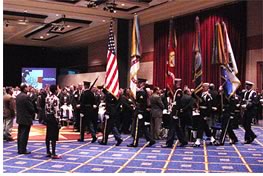 From
8:15 this morning, there was no doubt that Thursday February 28, was Government
Affairs Day for the AIA's Grassroots Leadership conference. Following
a moving "Presentation of the Colors" by the Joint Services
Color Guard, plus a rousing rendition of the national anthem, AIA President
Gordon H. Chong, FAIA, reminded the audience that Government Affairs Day
is about "knowledge and then engagement" in the political process.
"I would add a third and a fourth trait: passion and hope,"
Chong said, "'Hope' that we can
make a difference in helping to move toward a better quality of life for
all people, and 'passion' that we must!
From
8:15 this morning, there was no doubt that Thursday February 28, was Government
Affairs Day for the AIA's Grassroots Leadership conference. Following
a moving "Presentation of the Colors" by the Joint Services
Color Guard, plus a rousing rendition of the national anthem, AIA President
Gordon H. Chong, FAIA, reminded the audience that Government Affairs Day
is about "knowledge and then engagement" in the political process.
"I would add a third and a fourth trait: passion and hope,"
Chong said, "'Hope' that we can
make a difference in helping to move toward a better quality of life for
all people, and 'passion' that we must!
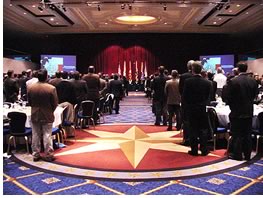 Chong
then bestowed Honorary Membership in the Institute on Rep. Frank Pallone
Jr. (D-N.J.), saying that Pallone was one of the "Magnificent Eight"
people whom the Institute so honored this year. He noted Pallone's accomplishment,
particularly his environmental stewardship during his seven terms in the
House. Pallone introduced the Brownfields Revitalization and Environmental
Restoration Act of 2001, which was just signed into law by President Bush.
(Click
for details.)
Chong
then bestowed Honorary Membership in the Institute on Rep. Frank Pallone
Jr. (D-N.J.), saying that Pallone was one of the "Magnificent Eight"
people whom the Institute so honored this year. He noted Pallone's accomplishment,
particularly his environmental stewardship during his seven terms in the
House. Pallone introduced the Brownfields Revitalization and Environmental
Restoration Act of 2001, which was just signed into law by President Bush.
(Click
for details.)
"Thank you—it is truly an honor to be recognized, but also to be a member of your Institute, Pallone said. "One of the reasons I am proud to belong to the AIA, and find it easy to work with architects in general, is that you care so much about the environment." Pallone urged participants to talk about the importance of school construction and energy efficiency to members of Congress. "These are issues on which we can bring people together."
 Keynoter
Allard: Business as war
Keynoter
Allard: Business as war
AIA President-elect Thom Penney, FAIA, as chair of the Grassroots conference,
had the privilege of introducing Thursday's keynote speaker, Kenneth Allard,
PhD, Col. U.S. Army (ret.), senior associate for the Center for Strategic
and International Studies, and military expert on MS-NBC. Allard told
the group that he wanted to talk about what he calls "Business as
War"—some of which we have rediscovered after 9/11.
But first, he offered some advice: "Don't admit that you ever designed a building or anything for Enron," "don't be too partisan; if you're from Florida, don't say you voted for both of them," and "don't use the word "intern," Allard joked.
Allard used an example from history—medieval fortress architecture—to explain how flexibility is important to providing security. While stone fortresses were state-of-the-art protection, they were challenged by the acquisition of gunpowder and cast-iron cannons to fire granite missiles. It was the architects of the Middle Ages, he explained, who invented new levels of security through design—with moats, flankers, and crenellations in castle walls. "They effectively turned the enemy's strength into weakness," he explained" Architects had the attention of leaders in the middle ages; they have their attention now, he said.
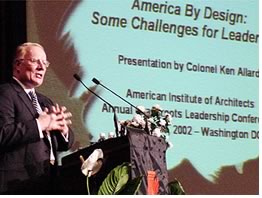 The
colonel also praised the AIA's new Security
by Design book for delineating the thought process for protecting
buildings post-September 11. "This is exactly the right idea,"
he said. He further stressed the importance of interdisciplinary thinking
and the need to balance freedom with protection. "You architects
are trained for that—and I think it's a contribution that is much
needed now," Allard opined.
The
colonel also praised the AIA's new Security
by Design book for delineating the thought process for protecting
buildings post-September 11. "This is exactly the right idea,"
he said. He further stressed the importance of interdisciplinary thinking
and the need to balance freedom with protection. "You architects
are trained for that—and I think it's a contribution that is much
needed now," Allard opined.
Allard left the audience with these final thoughts:
• Creativity counts. "Thank God for L'Enfant [architect of the
original master plan for Washington, D.C.]," he said. "Our capital
city was designed to be beautiful as well as functional."
• Leadership counts, too, because it can bring people together
• Creative local leadership counts more than anything else. "Security
is a grassroots issue, Allard said. "The solutions are not in Washington,
(except when the AIA conference is in town). You've got some awfully good
ideas that this country needs to think about."
Allard's address was sponsored by the McGraw-Hill Construction Information Group.
The issues
Harking back to Chong's watchwords of "knowledge and engagement,"
AIA Managing Director of Government Affairs Lisa Blackwell, presented
the knowledge part: the legislative issues for this year's visits to Capitol
Hill:
• Building Security Through Design (the main focus)
• The Truthfulness Responsibility and Accountability in Contracting
Act (TRAC)
• Energy Efficiency in Buildings
• School Modernization. (Click
for details.)
Blackwell also filled participants in on the attractive lapel pins—silver AIA eagle on a stylized flag background—that they would present to members of Congress, with a card that says, in part, "The American Institute of Architects salutes the leadership role of the U.S. Congress as enlightened steward of our nation's Capitol. . . . We acknowledge the challenge of balancing the need for the public's security and the ideals of an open society, and offer you our support in accomplishing this great task."
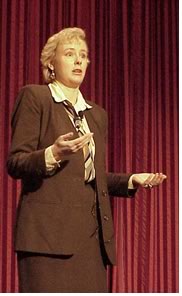 Lobbyist
and ex-congressional staffer Stephanie Vance, principal of AdVanced Consulting
and author of "Government by the People: How to Communicate with
Congress" (AdVanced Consulting, 1999) provided the how-to for the
engagement part, through a speech titled "The Process: Lobbying Congress."
Lobbyist
and ex-congressional staffer Stephanie Vance, principal of AdVanced Consulting
and author of "Government by the People: How to Communicate with
Congress" (AdVanced Consulting, 1999) provided the how-to for the
engagement part, through a speech titled "The Process: Lobbying Congress."
Vance impressed upon the audience that members of Congress truly have hectic schedules, ans it important to make them realize—right off the bat—how you are important to their home district. Before you engage the representative or a staff, she advised, ask yourself:
• What do you want? (Be specific—is it
a site visit to a new building or a newsletter article? Make them think
about you
• Who should be asked? (Why are you relevant to this elected official's
district. "If you want something to happen, it has to be bi-partisan,"
Vance advised. "The Brownfields bill is a perfect example."
• How should you ask? Know your facts, be positive, make the issue
your own personal issue. "Be prepared to deliver your message in
five minutes," Vance concluded.
Shields peppers political
food for thought
On a lighter note, political journalist and moderator of CNN's "The
Capital Gang," Mark Shields turned his 30-something years of experience
in covering American politics into a discussion of "The Landscape:
Insights into the Political Environment."
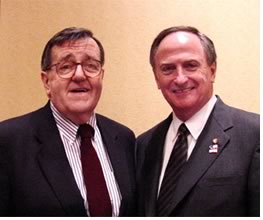 Shields
poked fun at politicians, including presidential candidate Steve Forbes,
whom Shields labeled the representative of the "angry affluent,"
and a man who had once confessed to "ordering house Chablis."
Shields had the audience in stitches by making fun of politicians from
Truman to Gore and the President.
Shields
poked fun at politicians, including presidential candidate Steve Forbes,
whom Shields labeled the representative of the "angry affluent,"
and a man who had once confessed to "ordering house Chablis."
Shields had the audience in stitches by making fun of politicians from
Truman to Gore and the President.
Americans are the most optimistic people on the face of the planet; we're also pragmatic, Shields explained. When any president lets us down, we have a great enthusiasm for what will come happen next.
Then he struck a serious note, speaking about the aftermath of September 11. "George Bush began 2001 as a question mark, and ended it as an exclamation point," he said. "He was inaugurated in January; he became president in September."
The presidency also became stronger, as always happens in war or any national emergency. Also, the presidency has recaptured the "commander in chief role again, according to Shields. Also, "you will hear very little anti-government rhetoric now, Shields said. "As a response, government is stronger and bigger. In this time of change, "we have to decide what we want America to be for," Shields concluded.
The importance of
ArchiPAC
"It's a sure bet that somewhere during Government Affairs day there
will be a plug for the AIA's PAC. The only question is when. Well, this
is it!" Penney quipped. He explained that he didn't mind pitching
for ArchiPAC, because he feels so strongly about its importance. Bill
Smith, FAIA, Texas Regional Director and chair of the Ambassadors Program,
along with Hon. Chris Widener, FAIA, past PIA Council Chair and former
Ohio State Legislator (who's running for election again this year) highlighted
the importance of the AIA's political action fund. Smith presented a proposed
new structure that would have four executive trustees to help the ArchiPAC
reach its $200,000 goal for 2002 (that's $2.98 per AIA member).
It was a morning brimming with good advice, some
proud patriotism, and the appropriate dash of humor. Thus armed, the participants
assembled into their constituent groups and prepared to engage Congress
on the Hill.
Copyright 2002 The American Institute of Architects. All rights reserved.
![]()
|
To read or about or order the AIA's Security by Design booklet, visit the opening page of AIA.org |
|